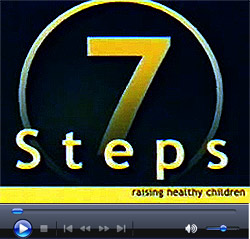- Health Emergency Home
- HED Current Projects Listing
- Spirituality, Health and Healing
- Family Health
- Men's Health
- Women's Health
- Child Health
- NBCI Health Television
- Health Notes
- Health Articles
- Health Books
- Food and Nutrition
- Physical Health and Fitness
- NBCI Clinical Approach Principles
- Health
Initiative
A to Z
NBCI Search
NBCI Health Television
 Raising
Healthy Children: A Guide for African American Families
Raising
Healthy Children: A Guide for African American Families
American Academy of Pediatrics and The Congress of National Black Churches
NFL player Ronde Barber, photographer Shari Belafonte, and former Surgeon General David Satcher, MD offer 7 steps for learning, nutrition, regular exercise, and more.
The Black Church and the Importance of Good Nutrition
What the black church needs to
say to its congregations
about good nutrition.
Organizations May
Work with the
Black Church
Producing Effective
Health Promotion
and Policy Initiatives
Companies
African American
Leaders Call on
Tobacco Industry
to Stop Targeting
Their Community
NBCI Declares a National Health Emergency in the Black Church

The U.S. Food Environment Atlas

Food environment factors—such as store/restaurant proximity, food prices, food and nutrition assistance programs, and community characteristics—interact to influence food choices and diet quality. Research is beginning to document the complexity of these interactions, but more is needed to identify causal relationships and effective policy interventions.
Objectives of the Atlas:
- To assemble statistics on food environment indicators to stimulate research on the determinants of food choices and diet quality
- To provide a spatial overview of a community's ability to access healthy food and its success in doing so
What information is included in the Atlas?
The Atlas assembles statistics on three broad categories of food environment factors:
- Food Choices—Indicators of the community's access to and acquisition of healthy, affordable food, such as: access and proximity to a grocery store; number of foodstores and restaurants; expenditures on fast foods; food and nutrition assistance program participation; quantities of foods eaten; food prices; food taxes; and availability of local foods
- Health and Well-Being—Indicators of the community's success in maintaining healthy diets, such as: food insecurity; diabetes and obesity rates; and physical activity levels
- Community Characteristics—Indicators of community characteristics that might influence the food environment, such as: demographic composition; income and poverty; population loss; metro-nonmetro status; natural amenities; and recreation and fitness centers
The Atlas currently includes 90 indicators of the food environment. The year and geographic level of the indicators vary to better accommodate data from a variety of sources. Some data are from the last Census of Population in 2000 while others are as recent as 2009. Some are at the county level while others are at the State or regional level. The most recent county-level data are used whenever possible.
Obesity and its Health Impact

Healthy Weight: Assessing Your Weight: Body Mass Index (BMI)
This Centers for Disease Control and Prevention (CDC) Web site explains the significance of BMI as an indicator of weight status for adults, children, and adolescents. Users can input their height and weight into a "BMI Calculator" and follow a link to obtain the CDC's growth charts for babies, children, and adolescents.Crafting Laws and Policies to Fight Obesity
State Legislative Information
Scroll down to State Legislative Information to access a database sponsored by the CDC that lists state legislative initiatives on nutrition and physical activity.American Council for Fitness and Nutrition
Web site of the nonprofit organization formed in 2003 by a coalition of food and beverage companies, trade associations, and nutrition advocates to "work toward comprehensive and achievable solutions to the nation's obesity epidemic." Lists federal government initiatives and some workplace and community-level efforts, as well as programs sponsored by food and beverage companies. It's a starting point for learning about the food industry's response to the epidemic.American Dietetic Association
Web site of the nation's largest organization of food and nutrition professionals, which has a section on Government Affairs with helpful information on food policy.National Conference of State Legislatures
Database for looking up state legislation on many health topics.California Center for Public Health Advocacy
Provides examples of how California nutrition activists have pioneered the approach of using specific local data on children's obesity and diabetes risk as a lobbying tool to engage voters and to encourage local and state legislators to pass new laws on school food and other issues. Activists in other cities and states are beginning to adopt this approach.The Guide to Community Preventive Services
This Web site of a nonfederal community task force on preventive services provides information on the strength of the evidence supporting various strategies for improving nutrition and promoting activity.Healthy Eating

Kidnetic.com
An interactive Web site for children ages 9 to 12 and their parents that promotes healthy eating and active living. It's a project of the International Food Information Council Foundation.IFIC | Food Safety, Healthy Eating and Nutrition Information
This International Food Information Council Foundation web site also offers general nutrition information and child-feeding tips for parents. IFIC is supported by the food, beverage, and agricultural industries.Food and Drug Administration - Food Labeling and Nutrition Education Tools
Learn how to read and interpret the nutrition information on food labels at this Web address, part of the Food and Drug Administration's Web site. Also provides a lesson kit on food labels for high school teachers.Shape Up America!
A nonprofit organization dedicated to helping people achieve and maintain a healthy weight.U.S. Department of Agriculture
By clicking on the Food and Nutrition link, you can find the latest edition of the government's dietary guidelines, standard serving sizes, the Food Guide Pyramid (including recommended servings for children of different ages), facts about the federal school lunch program, and other valuable information. There's also an Interactive Healthy Eating Index and Physical Activity Tool that allows the user to input personal information about diet and activity patterns and get an individualized assessment.Promoting Access to Fresh Foods

































